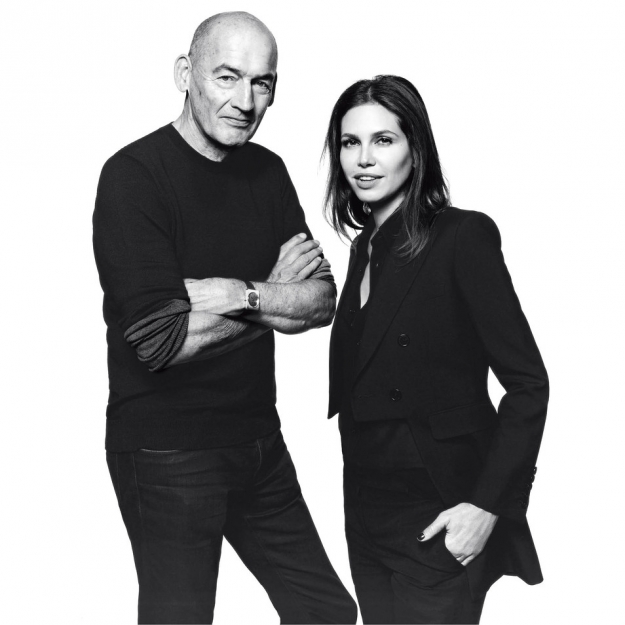Rem Koolhaas and Dasha Zhukova Build a Moscow Museum

Art collector and philanthropist Dasha Zhukova is launching an ambitious campaign to connect Moscow to the international art world, and she’s tapped architect Rem Koolhaas to execute her vision.
It’s a radiant day in Moscow, and two of the city’s most creative collaborators, Dutch architect Rem Koolhaas and Russian-born art impresario Dasha Zhukova, have donned white construction helmets as they stride excitedly through Gorky Park, the 300-acre riverside expanse that was, until recently, a symbol of Russia’s urban blight. Created in the 1920s as a Soviet recreational paradise, the once-verdant park fell into decay after the collapse of the U.S.S.R. in 1991, its barren fields scattered with broken carnival rides and roamed by drug dealers. The $2 billion renovation, which began in 2011, has transformed Gorky Park overnight into an Oz-like retreat, amid Moscow’s economic tumult, that would not seem out of place in Seattle or Barcelona. We pass manicured lawns adorned with flower gardens; chic cafes serving gyoza and wood-fired pizza; and yoga and capoeira classes by the Moscow River. There are jogging trails and a state-of-the-art bicycle-sharing program. Wi-Fi is available in every leafy nook.

For the past two years, the most exciting attraction in this cosmopolitan Arcadia has been cultural: the Garage Museum of Contemporary Art, Zhukova’s ambitious attempt to connect Moscow to the international art world. Garage was named for its original home in a more remote area of the city, an avant-garde bus depot from the 1920s designed by the revered constructivist architect Konstantin Melnikov. Founded in 2008, it introduced Russians to global art stars such as Marina Abramović, John Baldessari and James Turrell — a radical notion in a country that had been cut off from Western artistic influences for decades. “Garage was the first space truly dedicated to contemporary art,” says Sandra Nedvetskaia, the director of the Cosmoscow art fair, held in Moscow last September. “Those early shows were unprecedented for Russia. Garage paved the way.”
Trailed by an entourage of young Russian art experts on the Garage team, we gingerly step over debris to enter the time-battered shell of the Brezhnev-era building. I’m immediately struck by its soaring ceilings and wraparound windows, which allow sunshine to stream in. The centerpiece is a crumbling mosaic, a kitsch-heroic Soviet image of autumn personified as a wild-haired woman, the last of the seasonal images to survive. Instead of erasing the building’s scars, Koolhaas has kept them as a central part of his design. “The building is basically a found object,” he says, pointing with approval at the battered pillars and gaping holes. “We are embracing it as it is.”

“Rem likes to challenge the white-cube tradition of Western museums,” Zhukova adds. “The raw brick and broken tiles will be a more stimulating backdrop for art.”
Garage has been attempting to forge ever-closer links to the global art scene. And, as the design for Vremena Goda shows, it’s doing so in a way that embraces Russia’s turbulent past. “Soviet architecture has one quality that is not generally recognized: its generous proportions,” says Koolhaas, dismissing the recent fashion for reviling and demolishing any relic of the Communist era. “We maintain that original aesthetic.”
The intact structure will be encased in a double layer of polycarbonate plastic, a translucent box that hovers six feet above ground. This exoskeleton will allow light to filter in during the day and project outwardly after dark. “The existing structure will be wrapped in a new layer, giving it a modern depth,” Koolhaas explains. Even the mosaic is being maintained in its damaged state by a conservator from Florence. In addition, one enormous wall of the new structure will slide open to reveal an atrium for large commissioned artworks. There will be a roof terrace, cafe, screening room, bookstore and outdoor sculpture—all the trappings familiar to museum-goers from Sydney to Shanghai, but lavish indulgences in Russia, where unimaginative, poorly lit institutions, with glowering babushkas guarding every room, remain the norm.

“I have long been worried about the increasing size of art museums,” Koolhaas says. “At one point I calculated that our firm was competing for museums that would cover 34 football fields in area. It was a form of madness—a binge of overexpansion.” He recalls his own childhood in Holland, where compact art museums staged exhibitions that influenced him enormously. “To me there is no direct relationship between the size of a museum and what you can do.” We gazed up at a spray-painted wall. “At the same time, I became interested in architectural preservation as an antidote to the exhibitionism of new museums. Here, we are not restoring the building. We are preserving its decay.”
“Garage has raised the bar for Russian museums and galleries,” agrees curator Evgeny Antufiev, who also directs Garage’s grant system for young artists. “Gallery owners now realize the global language of contemporary art. When we put on a show, we have to ask: How would Garage do this? We have to do as good or better!”

The move to Gorky Park was a direct attempt to involve a skeptical Moscow public. “At the old Garage, there would sometimes be more workers than visitors,” says Belov. “Now Garage is thronged all day.” Apart from conferences and debates, a program where the public was invited to ask curators questions lured 30,000 visitors. There was even a Bring Your Grandmother to the Garage Day. “Being here has its positives and negatives,” says Zhukova. “People come in who don’t like contemporary art, or don’t know anything about it. We have to adjust the way we communicate.”
- Tags:
- Rem Koolhaas |
- Dasha Zhukova |
- Gorky Park






